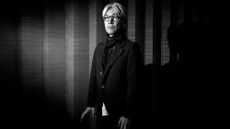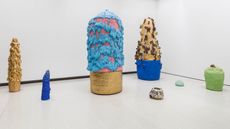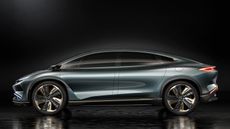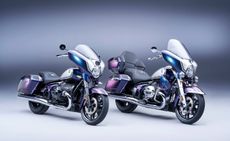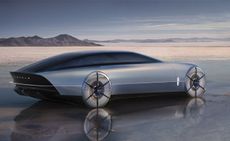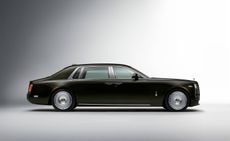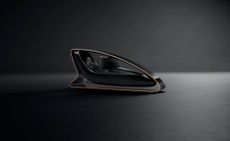Bentley's contemporary designers reform the ‘old school’ Flying Spur
- (opens in new tab)
- (opens in new tab)
- (opens in new tab)
- Sign up to our newsletter Newsletter
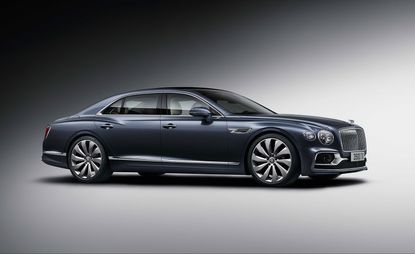
Bentley Motors was born on 10 July 1919 – its mission, to conquer continents in speed, in luxury, and in the ultimate gran turismo. And in the spirit of its centenary, the marque’s latest grand tourer, the Flying Spur, comes replete with a ‘Flying B’ mascot that progressively looks ahead and into the future. This is only the fourth Flying Spur to be created at Crewe – the first being the brilliant 1928 model, followed by the new era 2005 car and its successor from 2013. Built on a new lightweight aluminium structure, the 2020 Flying Spur is lighter and more powerful than the one it replaces. The 6.0-litre, twin-turbocharged W12 Bentley engine powering this grand saloon offers 635ps (625bhp) and 900 Nm of torque, with a top speed of 207mph and zero to 62mph possible in just 3.7 seconds.
Crucially, the Flying Spur is a canvas of sorts for showcasing Bentley’s design skills and the artistry of its Mulliner craft people who seemingly can make anything possible. This includes the novel three-dimensional diamond quilted leather and wood door inserts. The new car also features a novel grille design – a gloss black radiator matrix with bright chrome surround and vertical vanes. Wallpaper* met with the Bentley design director Stephan Sielaff at the centre in Crewe to discover more.

Wallpaper*: How did you start sketching a Bentley grand tourer that is an expression of the marque today?
Stefan Sielaff: It took us over four years to conceive this car, so it is a little like giving birth to a baby. The design and engineering teams at Bentley really worked together like family on this project. The Flying Spur shape is perhaps old-school in that it is a four-door limousine. So, the design is about expressing performance and luxury where art meets technology.
W*: The Flying Spur shares much of the visual language of the latest Continental GT – an older sibling, more poised, perhaps a touch conservative. How closely did you reference the sportier model?
SS: Yes, we wanted to create a stronger family design DNA. For instance, the three-dimensional crystal glass light theme we introduced with the Continental feature here. As you know we are evolving our design. Performance and luxury are at the heart of our identity, but so is craftsmanship – and we want to show our customer the art of craft, the human touch.

W*: The previous model appeared to be solely a chauffeured car. And although this Flying Spur shares similar proportions, it feels equally a driver’s vehicle. How does the design reflect this duel identity?
SS: The car has a new proportion, but the differences are subtle. What we did was to move the front wheel a few millimetres forward to allow for a shorter overhang and therefore better proportions. This Flying Spur is only 80mm longer than the previous car, but this small tweak has altered our perception. And what this does visually is make it a driver’s car rather than only a chauffeured limousine. Also, we worked on the Flying Spur as you would a sculpture to include the Bentley signature lines, powerline and haunch. Yet, whereas they were connected in the previous Flying Spur, here we separated these two lines for a very different proportion.
W*: The new grille design also gives the Flying Spur a completely different personality. Why did you decide on a radical move?
SS: The structure is entirely reshaped to include these vertical vanes sitting in front of the matrix design, which we took from the sportier Continental. We offer customers two design options – the black matrix to pump it up and feel sportier, or the full high-chrome spec. The unusual shape makes the car look more majestic; it says this is a mix of performance and luxury. Also remember, the design is in our DNA and tributes the 1957 S1 Continental Spur.

W*: You say the ‘Flying B’ mascot represents the Bentley centenary. What was the creative thinking behind this?
SS: It is a major highlight for us, taking two years to develop with 15 designers from our team participating. We really liked one of the sketches that showed a falcon landing on snow with a forward-leaning beak. We wanted to create more dynamism than the former mascot which felt static. The design symbolises the challenges facing us, so it needed to look proud and into the future.
W*: The cabin is a fusion of tradition and modernity, craft and technology, with all the intricate details which makes the Flying Spur unmistakeably a Bentley. How did you evolve the previous design?
SS: The customer must immediately feel that they are in a Bentley. So, we have the typical ‘wings’ incorporated into the centre dashboard, and all the user elements help form a strong family link. A highlight are the new diamond-themed air vents, for which we had to create our own software to achieve the 5,000-plus individual diamond shapes. We can even customise these for customers who want more ‘bling-bling’.

W*: The driver interface continues the Continental story with a mix of analogue and digital, and with the novel rotating display which swivels from an informative panel to a simple clear space. Is this a theme you are adopting on your cars?
SS: Yes, it comes from our new thinking: luxury means less is more. A customer is driving home from work, he or she just wants to listen to their music and relax, and they most likely know the way and don’t need too much visual noise. Also as the car is designed to be chauffeured and driven, we have created two zones with a remote control at the rear for passengers to specify their space. We are offering a wide range of interior colour options and it’s interesting to see how the colour layout can alter the character of this car.
W*: There seems to be quite a variety of quilting designs happening inside the Flying Spur. How has this very Bentley feature evolved for this car?
SS: The seats feature the diamond quilting theme we explored in the Continental but with more of a rhythm. Three-dimensional quilted leather and wood door panels are now available, thanks to the positive feedback from the press and customers. We feel it is a modern interpretation of our traditional design. The wood, especially, generates a very rich ambience; it looks like something precious that you won’t throwaway. I feel it represents a step towards sustainability.

W*: Talking of sustainability, how do you see the next chapter for Bentley design?
SS: We must push Bentley design forward a lot to make it more and more youthful and dynamic. Our times are becoming more interesting; our customer demands are changing. It is a very holistic subject because design is influenced by the change in society and by technology. In terms of the latter we will work with different propulsion systems which will give us positive possibilities as we can illuminate our design language. You can make big steps in design when you make big steps in technology.
W*: On 10 July, you will be revealing a radical concept to represent the next phase for Bentley. What can you say at this stage?
SS: The materials story will be very exciting. We have discussed finding new sustainable leathers and working with textiles, wool and cashmere. Going forward we will focus on finding materials that are locally sourced. We are excited to be experimenting with an Italian company to condense the surplus grapes and branches from winemaking and turning this into an interesting material. Changes in society and the whole subject around sustainability and social responsibility will be a poster for Bentley. Without forgetting our heritage of craft, it will push us to generate a more modern design language. §

INFORMATION
For more information, visit the Bentley Motors website (opens in new tab)
-
 Watch Ryuichi Sakamoto's mesmerising musical experience at the Brooklyn Museum
Watch Ryuichi Sakamoto's mesmerising musical experience at the Brooklyn MuseumAn iconic composer who traverses popular and high culture, Ryuichi Sakamoto pushes music into new frontiers, most recently in ‘Seeing Sound, Hearing Krug’, a new composition that pairs sound, flavour, light and texture
By David Graver • Published
-
 Last chance to see: ‘Strange Clay’ at The Hayward Gallery, London
Last chance to see: ‘Strange Clay’ at The Hayward Gallery, LondonAt London’s Hayward Gallery, group show ‘Strange Clay: Ceramics in Contemporary Art’ sees ceramic artists explore the physical, psychological, political and power of their medium
By Emily Steer • Published
-
 Aehra is Italy’s first all-electric luxury car brand. We preview its forthcoming SUV
Aehra is Italy’s first all-electric luxury car brand. We preview its forthcoming SUVAehra’s proposed electric SUV is brimming with cutting-edge technology. The Italian company hopes to shake up the high-end EV market in 2025
By Jonathan Bell • Published
-
 Flexjet takes to the skies with Bentley
Flexjet takes to the skies with BentleyFlexjet brings exclusive Bentley interiors to its new Gulfstream G650 jet and Sikorsky S-76 helicopter, in the smoothest of transfers
By Jessica Klingelfuss • Published
-
 Peugeot’s sparky 308 gets hybrid power and handsome lines
Peugeot’s sparky 308 gets hybrid power and handsome linesThe Peugeot 308 proves that mass-market design needn’t be dull, blending hybrid power with sharp lines and excellent detailing
By Jonathan Bell • Last updated
-
 BMW Motorrad brings out the big guns for its newest cruisers
BMW Motorrad brings out the big guns for its newest cruisersBMW Motorrad R 18 Bagger and Transcontinental set the tone for high-voltage cruising with a brand collaboration with speaker specialist Marshall
By George Chapman • Last updated
-
 Dacia’s new Manifesto concept is a true outdoor utility vehicle
Dacia’s new Manifesto concept is a true outdoor utility vehicleUtilitarian auto brand Dacia sets a bold new agenda with its Manifesto, a concept car pitched at the active outdoor market
By Jonathan Bell • Last updated
-
 The sun sets on traditional supercars at California’s Monterey Car Week
The sun sets on traditional supercars at California’s Monterey Car WeekMonterey Car Week, the world’s most prestigious car gathering, is showcasing ever-more extravagant special editions, coachbuilt cars and all-new electric concepts. Here are seven key machines from 2022
By Rory FH Smith • Last updated
-
 Is McLaren’s GT a sports car, a tourer, or the best of both?
Is McLaren’s GT a sports car, a tourer, or the best of both?The McLaren GT is a capable all-rounder dressed up in svelte supercar clothes. It might also be the last of its type
By Jonathan Bell • Last updated
-
 Rolls-Royce puts the Phantom back on its lofty pedestal
Rolls-Royce puts the Phantom back on its lofty pedestalA mid-life refresh ensures the flagship Rolls-Royce Phantom Series II is at the top of its game, a last hurrah for traditional engines before an electrified future
By Jonathan Bell • Last updated
-
 Prodrive’s new racing simulator is shaped by Callum to be front of the grid
Prodrive’s new racing simulator is shaped by Callum to be front of the gridThe racing simulator shapes up – this new design from Prodrive and Callum is honed for the high-end games room
By Jonathan Bell • Last updated
